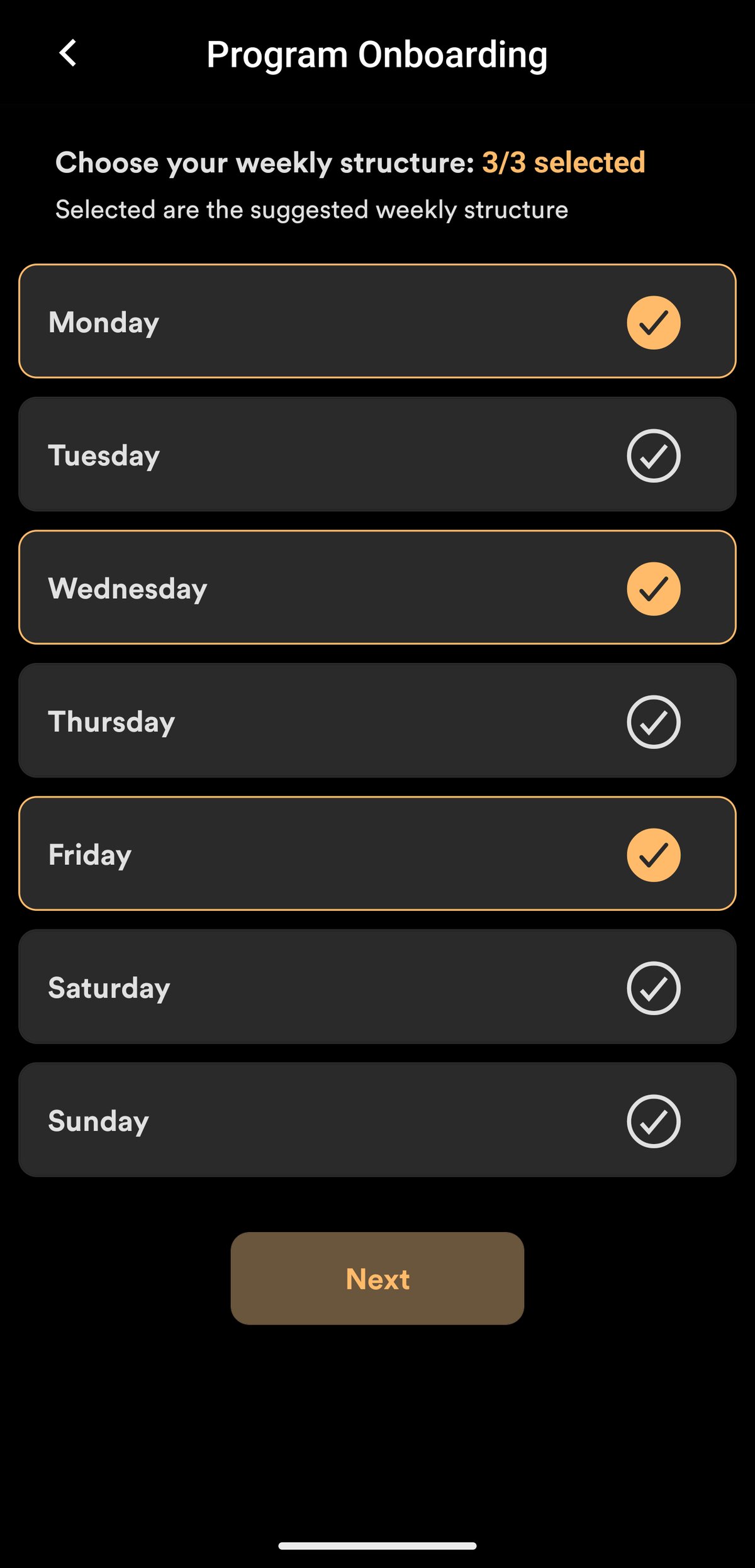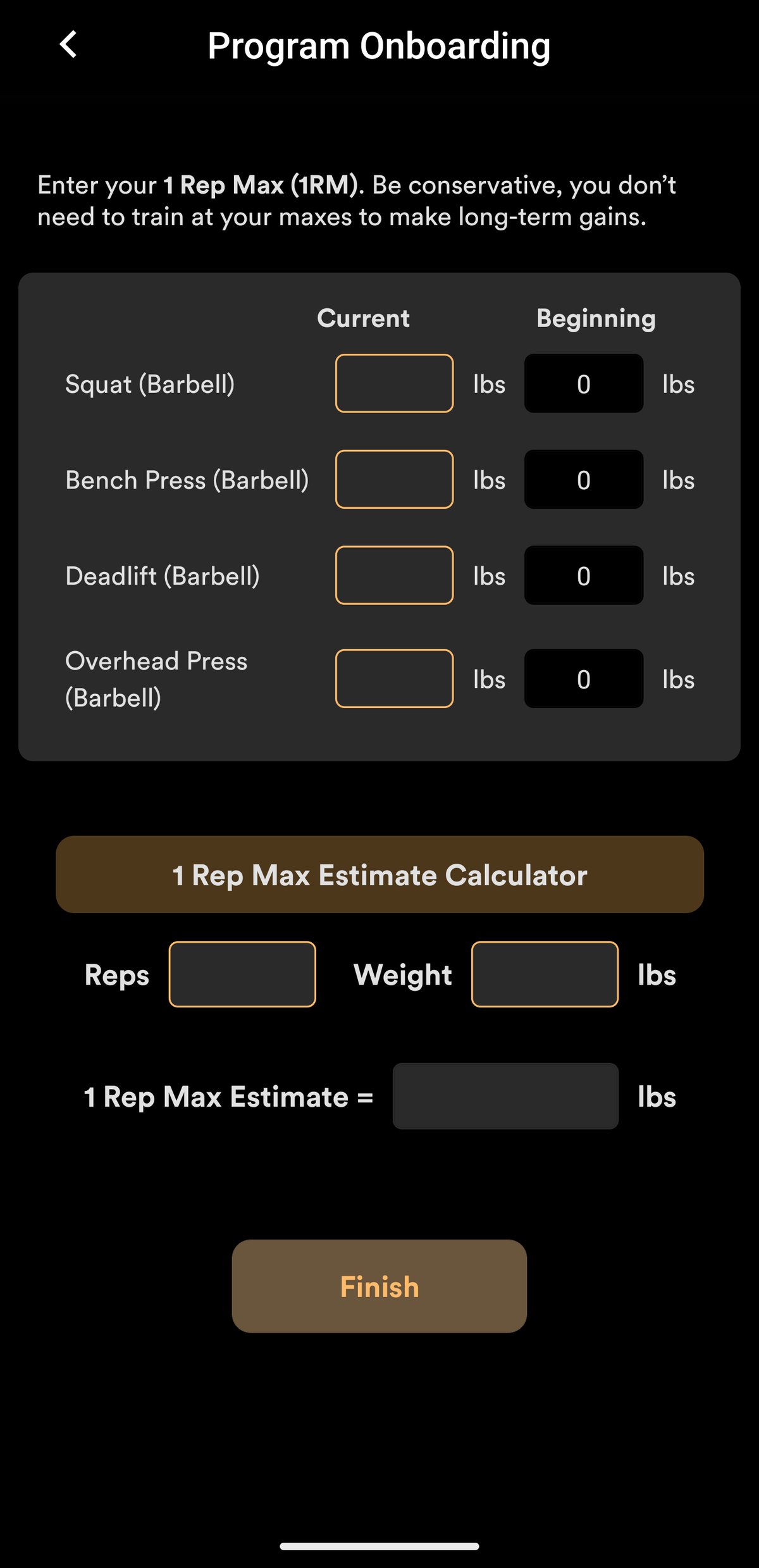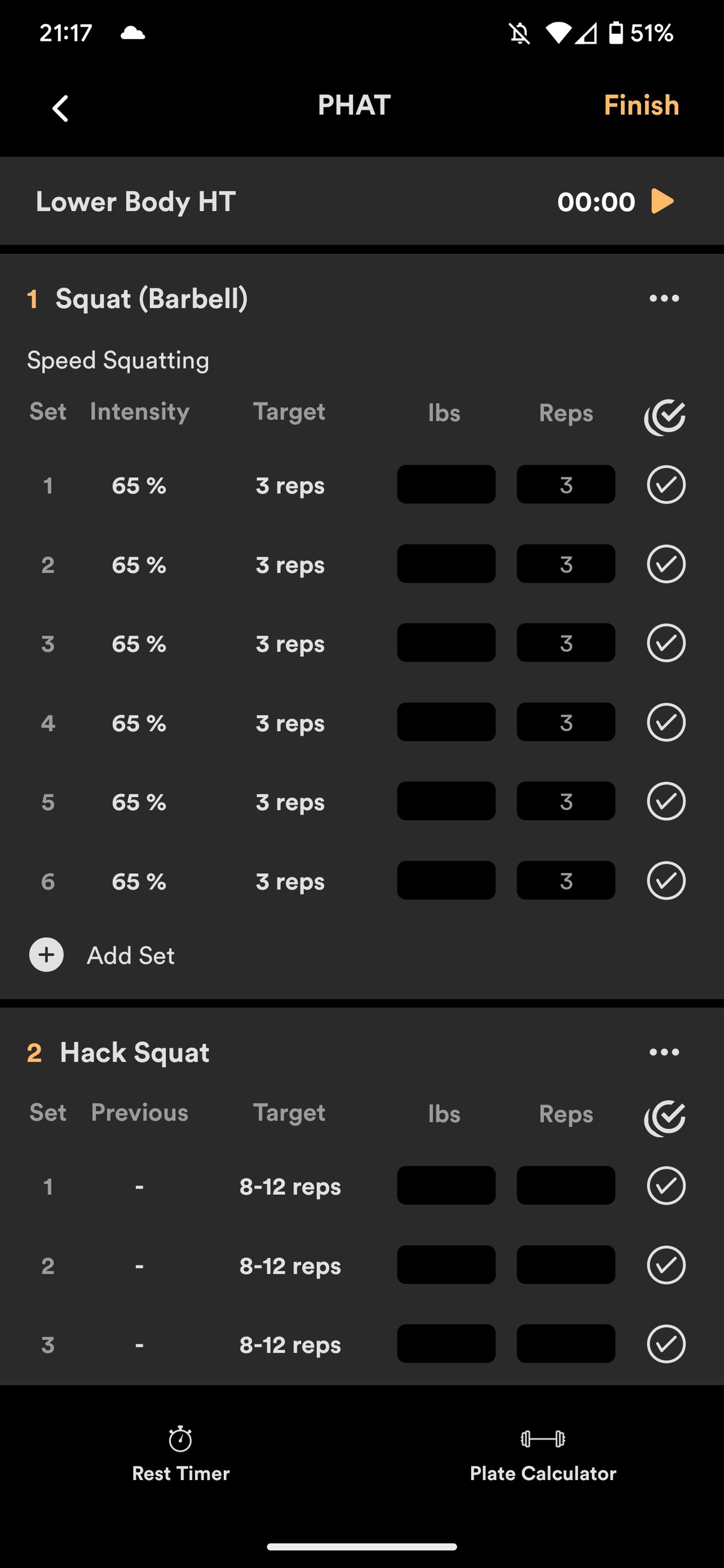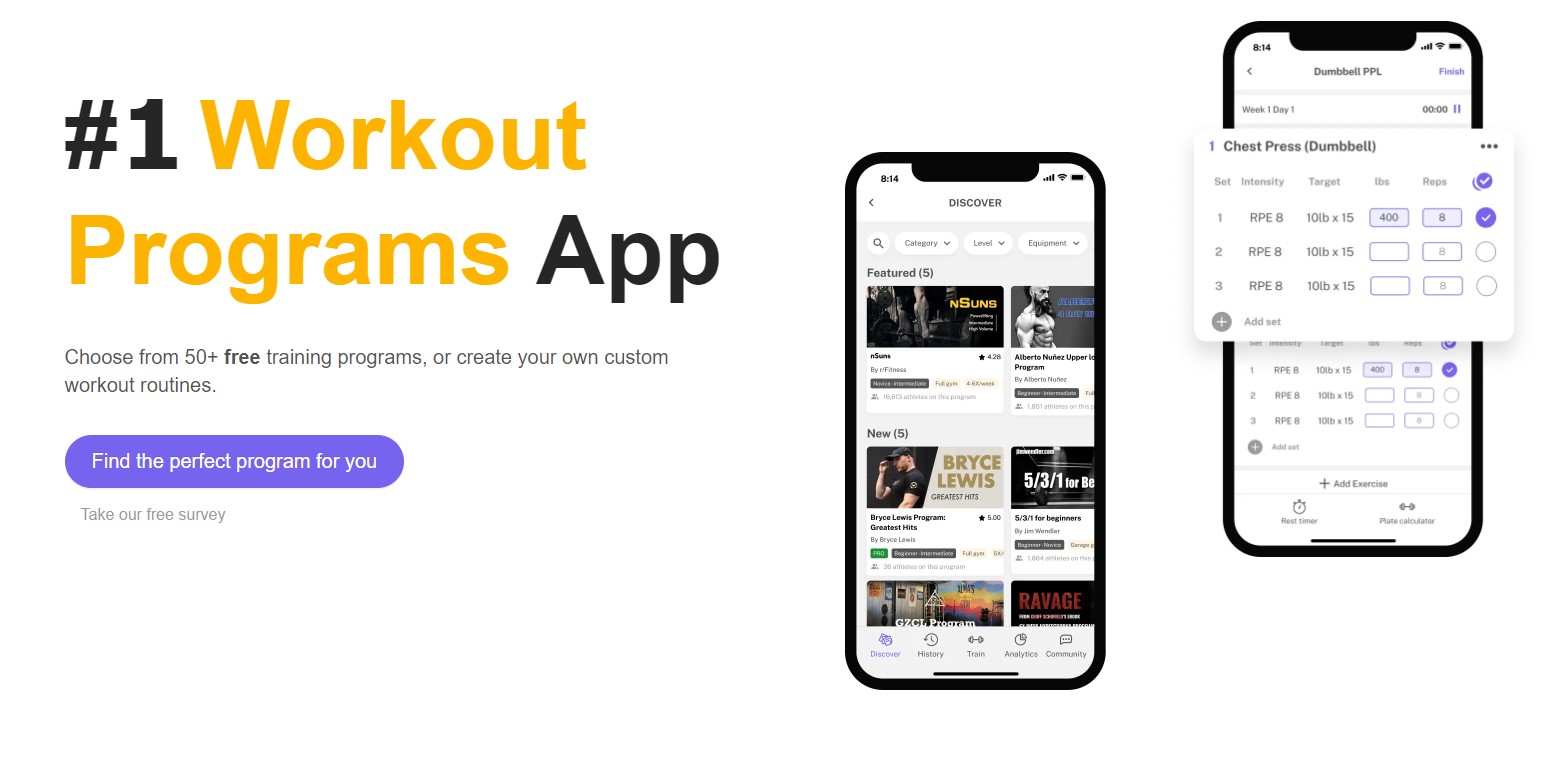PHAT (App & Program Guide)
Written by The Boostcamp Editors
Achieve Your Goals with the PHAT Workout Plan
The Power Hypertrophy Adaptive Training (PHAT) Program is a top of the line workout routine created by natural bodybuilder and researcher Dr Layne Norton. The underlying philosophy of PHAT is to combine the benefits of powerlifting and bodybuilding - by integrating the development of maximal strength in the 3 major compound barbell lifts of powerlifting with the hypertrophy principles of bodybuilding, the PHAT powerbuilding program, also known as the phat workout program, promotes improvements in strength training and muscle mass that will benefit a wide range of users.
The weekly structure of PHAT is divided into 5 training days. Day 1 and 2 are designated as power days for the upper and lower body respectively, incorporating PHAT training principles. The emphasis should be on large compound lifts, like front squats and deadlifts for lower body and barbell presses and weighted pull ups for upper body, in a smaller rep range for maximum weight. This is followed by 3 days of exercises in lighter weights for higher volume to promote optimal hypertrophy, including lower body power training on day 2. This can also be split into different body areas as chest, back, and lower body days. The end goal of the PHAT training program is for each body part to be exposed to both power and lower body hypertrophy training every week, targeting each muscle group a total of 2 times weekly.
Why Should You do PHAT?
As the PHAT workout is a hybrid training program that targets development in both strength and muscle size at the same time, the PHAT routine is well-suited for a wide range of weightlifters. Many lifters on the bodybuilding side may be skeptical of power training typically seen in powerlifting workouts, but in an article written by Norton himself, he outlines how using the principles underlying PHAT helped him direct achieve significant growth in muscle size, also known as muscle hypertrophy, in a span of mere months, resulting in gains that far outsized his results following a purely hypertrophy-based routine. Additionally, the PHAT workout, which involves lifting heavier weights and focusing on training volume, allows for a variety of training styles within the same training week, making it a versatile and effective choice for those looking to improve both strength and muscle mass.
The guiding principle of bodybuilding is often understood to be the maximization of muscle growth, with the weight lifted considered largely irrelevant to its practitioners. On the other hand, powerlifters focus on lifting the greatest possible weight. The PHAT program design seeks to increase the overall strength of your muscles through power exercises, which will in turn allow for high rep routines at an increased weight. If you are able to commit and stick with the PHAT workout split, incorporating proper diet and intense training, you will see greater growth in strength and mass in a significantly shorter period of time! Use the Boostcamp app to track your progress accurately and with detail, and to help you stay motivated to reach your goals!
Who is the PHAT Workout for?
Increasing the strength of the main muscle groups using the power portion of PHAT allows for hypertrophy exercises at higher weights, helping increase muscle mass for bodybuilders. Incorporating hypertrophy using the PHAT workout will also help powerlifters build more muscle mass along with strength improvements. By harnessing the benefits of both traditions, lifters from both camps can benefit from the use of barbell squats, hinge variations, bench pressing, and barbell rowing - the cornerstone exercises of the PHAT workout.
Make sure you are choosing manageable weights, particularly on hypertrophy days, or you may risk injury or burnout rapidly. Make no mistake, PHAT is a very demanding workout regimen. If you are only in the very beginnings of your workout journey, make sure to check out some more immediately accessible programs on Boostcamp such as the Greg Nuckols Beginner Program or the 5/3/1 for Beginners program, all for free on the app
Getting a little complicated? Don’t worry, use the Boostcamp app to visualize exercises on different days, learn more about variations, and track your progress all on your mobile device. The Boostcamp app is free to use and available for download on iOS and Android.
Getting Started Boostcamp Download and Onboarding
Key Features
Customize your schedule
The Boostcamp 5/3/1 for Beginners workout is designed to help you perform the routine correctly while tracking your progress conveniently. Use the interface to select the 3 days you will hit the gym that week:

Calculate and Input your weight parameters
As the PHAT workout is anchored on the three major power lifts, you will be asked to enter your 1 Rep Max (1RM) for each of the lifts. This is the weight you are able to perform 1 rep of the exercise. The name suggests that this is synonymous with the absolute maximum weight you are able to perform a single rep of the movement - while this is technically true, make sure the 1RM you enter was measured when doing the lift with proper form.

In the lower half of the screen you will see a 1RM calculator and outputs an approximate 1RM for you based on your current routine. To get a more accurate idea of your personal figures, simply go to the gym to find out the 1RM you are comfortable with. We suggest starting with a fairly conservative 1RM weight to help your body adapt to the volume and intensity of the PHAT workout. Don’t be alarmed or impatient if the lifts feel light to you initially; remember, the lifts are calculated as percentages of your 1RM, and you don’t need to be training at or very close to your maximum tolerance all the time for long term gains!
Begin your journey, and reap the rewards!
After the onboarding steps, simply select the corresponding day and week you are working and follow the listed exercises. Don’t forget to record your weight and reps after each set on the rightmost column of each row! Workout notes can be added to each day, and you are able to record the assistance work you performed in conjunction with the main lifts using the “Add Exercise” function at the end of the list. Simply select “Complete Workout” when you are done, and all of your progress will be recorded.
Proper form is paramount to getting the most out of your workout, while minimizing your risk of injury. Click on each exercise for videos to help you maintain proper form and posture through each movement.

PHAT Program FAQ
How should I warm up for a PHAT workout?
Properly preparing your body for the physical intensity of the PHAT workout is extremely important in order to get the most of our work exercise and reduce the risk of injury. Prior to beginning the PHAT routines, make sure you do some lighter sets to prime your body and mind for the exercise, lowering the chances of pre-exhausting your muscles. We recommend the use of a reverse pyramid warmup scheme, with lower weights and higher reps to start and then gradually increasing weights and while lowering the rep count.
How can I prevent overtraining on PHAT?
Given the intensity of the PHAT workout, it is likely you will feel quite sore and tired for the first few weeks. It will take some time for your body to adapt to the intensity of PHAT, and from then on you will see clear results from your hard work. Consider deloading for 1-3 weeks, lifting at weights that are around 70% of your normal weight to help with active recovery while ensuring that your strength is maintained.
To help prevent burnout, it is recommended that you do not lift to failure on hypertrophy days for the first couple of weeks. Afterwards, you may want to incorporate training to failure into your hypertrophy sets, but we suggest only doing so for the final sets of each exercise. Remember that building strength and mass is a gradual process, and overexerting to the point of burnout will not be conducive to your long-term goals.
What lifestyle considerations should I take into account?
Consume a meal with plenty of protein and carbohydrates a few hours prior to training, and ensure that you have a high-protein meal within hours after your PHAT workout to kickstart recovery and growth. Make sure you get sufficient sleep to help with muscle recovery, which is especially important if you want to see progress on an intense routine such as the PHAT workout split.
How long should I run PHAT? How many weeks to do PHAT?
Ideally do the program as prescribed for at least 6-12 weeks.
You can keep running the program as long as you are seeing consistent gains.
How to find starting weight for PHAT?
Always start with light weights as warmups. Your primary goals with these sets are to warm up and practice good form, not burn out. Do not go to failure on warm-ups.
Your other goal with warmup sets is to slowly work up to a weight that starts to feel difficult, which will be your first working set (i.e. your recorded set) within the rep range targets.
Your goal is RPE 8-9 for every working set, which means stopping 1-2 reps before failure on every set. Working to failure, which includes degradation in form, is not advised for beginners due to chance of injury.
If the set is 3x3-5 (meaning 3 sets of 3-5 reps per set), warm up to a 1st working set that you can do for 3-5 reps. Do the same for the following 2 sets.
EXAMPLE: if the exercise is flat barbell bench of 3x3-5, and from prior experience, you roughly know that you can do 135 lbs for a few reps. So you might do:
Warmups: 45x8, 95x5, 115x3
Working sets: 135x5, 135x4, 135x3 (you stopped at 3 reps because you feel like you might miss the 4th rep)
Warmups: 45x8, 95x5, 115x3
Working sets: 135x5, 135x4, 135x3 (you stopped at 3 reps because you feel like you might miss the 4th rep)
When should I increase my load on PHAT?
Every workout, aim to add either weights OR reps for every set:
If last week you were within the target rep range for all 3 sets, but not at the top of range, then aim to add 1-2 reps.
For example, if target range is 3 sets of 3-5: if you were at 135 lbs x5,4,3 last week, then this week aim to do 135 lbs x 5,5,4. Repeat next week until you are at 135 lbs x 5,5,5
If you were at the top of target rep range for all 3 sets, increase weight slightly (e.g 5 lbs)
For example: if last week you were at 135 lbs x 5,5,5, then this week go to 140 lbs x 3-5 per set at RPE 8-9
If last week you were within the target rep range for all 3 sets, but not at the top of range, then aim to add 1-2 reps.
For example, if target range is 3 sets of 3-5: if you were at 135 lbs x5,4,3 last week, then this week aim to do 135 lbs x 5,5,4. Repeat next week until you are at 135 lbs x 5,5,5
If you were at the top of target rep range for all 3 sets, increase weight slightly (e.g 5 lbs)
For example: if last week you were at 135 lbs x 5,5,5, then this week go to 140 lbs x 3-5 per set at RPE 8-9
For example, if target range is 3 sets of 3-5: if you were at 135 lbs x5,4,3 last week, then this week aim to do 135 lbs x 5,5,4. Repeat next week until you are at 135 lbs x 5,5,5
For example: if last week you were at 135 lbs x 5,5,5, then this week go to 140 lbs x 3-5 per set at RPE 8-9
What is RPE in PHAT
RPE = Rate of Perceived Exertion
The RPE scale is used to measure the intensity of your exercise. The RPE scale runs from 0 – 10. The numbers relate to phrases used to rate how easy or difficult you find an activity. In weight training, a RPE 10 means that it was a max effort set (i.e. you are at point of failure and cannot do another rep), RPE 9 means you have 1 rep left before failure, RPE 8 means 2, etc...
For PHUL, we recommend RPE 8-9 per set within the recommended rep range. This means the weight should be heavy enough that you stop 1-2 reps before failure.
How long should you rest between sets?
Adequate rest is important to perform each lift with the optimal energy level, but having too much of a gap is also not ideal
Use 1-3 minutes as a general rule, varying based on what % of 1RM you are lifting at
Take as long as you need to recover for full strength
When Should I Switch to a different Program?
If after 6-12 weeks, you are still seeing gains, keep doing the program. Don’t fix what ain’t broke!
If you have been stalling for 2-3 weeks, that does not mean it is time to switch the program yet.
First, assess what the stalling could be due to:
Nutrition: are you steadily gaining bodyweight? (i.e., 0.3-1 lbs bodyweight per week). If not, you could be not eating enough calories to fuel your recovery. Make sure you’re getting adequate protein and carbs to fuel your training.
Sleep: are you getting 8+ hours of quality sleep? For demanding training like PHUL, getting great sleep is critical.
Form: are you doing the exercise correctly? Could your form be better, which would help you increase weights? Post your video to Reddit r/boostcamp to get feedback from the community.
Stress: are you stressed from work or life? if so, that could affect your recovery. Your body does not differentiate between training stress and work stress, so make sure you find ways to alleviate it (meditation, walks, fam time).
Deload: have you taken a deload every ~4 weeks? If not, go 50% of your normal weights for a week and let your muscles, joints, and mind recovery so you can come back even stronger. 1 step back, 10 steps forward.
Lastly, are you just going too heavy? Don’t ego lift. Lighten the weight by 10% and push it slowly backup.
Once you’ve tried all of the above (and don’t try to fix everything at once; start with 1-2 of the biggest hurdles), then consider switching to a different program.
What program to do after PHAT?
nSuns 5/3/1 - one of the most popular programs ever made, with 4-6 day program variations available on Boostcamp.
GZCLP - the modern alternative to 5x5 and Starting Strength. Made by world-class coach and Marine veterine Cody Lefever (GZCL).
Candito 6-week Strength Program - a fun 6 week strength peaking program by champion powerlifter Jonnie Candito.
When to do cardio on PHAT?
Cardio is not prescribed in PHUL, so do at your discretion
Doing cardio is beneficial for increasing your work capacity (and general health), so 2-3x a week is recommended
Cardio should aid your training, not detract from it. This means that you shouldn’t go too hard or too often. Use your own judgement
How to eat on PHAT? Can do I PHAT on a cut?
To maximize the effectiveness of the PHUL program, we suggest that you eat at a slight calorie surplus (~500 calories per day above maintenance), and aim to gain 0.3-1 lb of bodyweight per week
The rate of bodyweight gain depends on your current level and muscle mass. For beginners, you can be on the higher end of the range or even go above 1 lb/week. If you are already decently advanced, then 0.3 lbs per week would be sufficient.
Ensure that you are eating an adequate amount of protein (0.5-1 g per pound of bodyweight).
Can you cut weight on PHUL? Yes you can, but just be aware that you are more likely to stall as you would on ANY program. There is no such thing as a program that is better for cutting.
Can I gain muscle and lose fat at the same time on PHAT?
Body recomposition is definitely possible for beginners or detrained individuals
Research also shows that it is possible for more advanced trainees, but everything has to be dialed in (training x diet x sleep)
For more details on body recomp, we suggest you read Stronger by Science articles by Greg Nuckols
More Workout Programs
If the PHAT program is not something that you want to do, the Boostcamp App has plenty of different workout programs to choose from, but you can also create your own. You can do whatever you want with the workout programs that you create, schedule, exercises, more.
PHAT Program Wrap Up
For finding the best training routines, check out the Boostcamp App, where you can choose from over 50 free training programs or even create your own. Boostcamp also allows you to track progress, so you know how to adjust each week.
Be sure to follow Boostcamp on Instagram and subscribe on YouTube!


